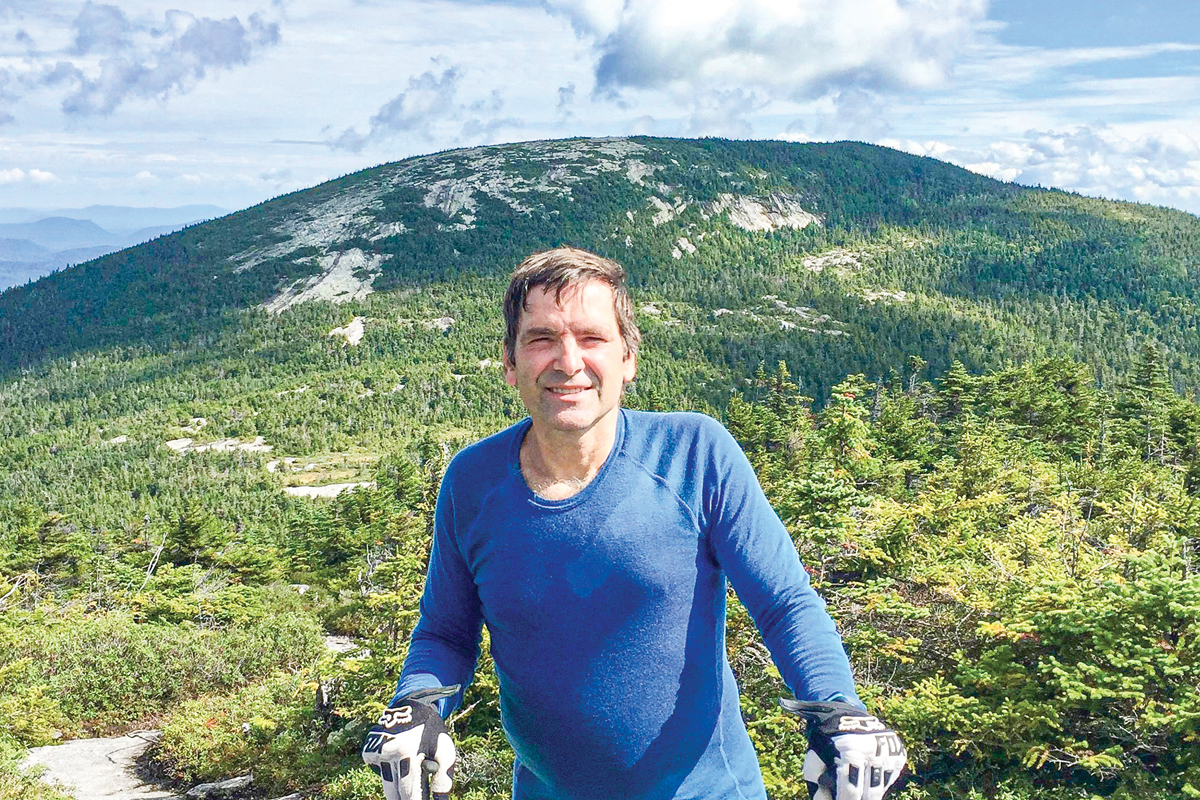Finding healing and acceptance at the end of a trail
 Author Peter Conti stands before Baldpate Mountain in Oxford County, Maine, near the northern end of the Appalachian Trail. Peter Conti photo
Author Peter Conti stands before Baldpate Mountain in Oxford County, Maine, near the northern end of the Appalachian Trail. Peter Conti photo
Peter Conti seemed destined for a life of chronic pain.
For nearly two years after a devastating motorcycle accident left him with a shattered pelvis and nerve damage in his leg, Conti battled depression and suicidal ideation while struggling to manage his debilitating, demoralizing condition with dangerously addictive opioids.
Ultimately, he refused to accept his disability as permanent and years later, high atop Mt. Katahdin in Maine, discovered an unlikely path to recovery.
“I had to take responsibility for it myself and stop thinking, ‘Just give me a doctor or a pill, I want someone to make all the pain go away immediately.’ I had to accept the responsibility to find a way to heal myself and not hope that someone else would do it for me,” said Conti, who chronicles his recovery in his 2021 memoir, “Only When I Step on it” (Adversity Press, 2021, 465 pages).
Originally from Maryland, Conti was an avid motocross racer in high school and later moved to Colorado, opening his own motorcycle and auto repair shop before selling it and getting involved with commercial real estate.
“I had my share of injuries, mostly broken bones and things that got healed up fairly quickly,” he said, noting that although he’d drifted away from the sport as he grew older, the temptation was always there.
Related Items
In 2015 at the age of 53, Conti entered a race in New Jersey, set on an 11-mile course through the woods. Initially, he was content to take it easy and bring up the rear, but when he ended up getting lapped, that old competitive spirit kicked in and propelled him forward.
“Within a couple minutes, I clipped a tree and went over the handlebars,” he said. “I shattered my hip, dislocated my femur and ended up on a helicopter ride to the hospital.”
There, Conti said, they put the femur back into the shattered pelvis to protect the cartilage, but in doing so, damaged a nerve in his leg.
“On a scale of one to 10, that took the pain to like, 200,” he said.
Three plates, 14 pins and a six-hour surgery later, the damage had been done. Incredible pain in his left foot and calf — even though there was nothing physically wrong — became his constant companion.
Conti saw 23 different doctors and tried everything from acupuncture to massage to electronic gizmos but ended up on oxycontin for 18 months.
The legitimate medical use of oxycontin has ensnared more than a few unwitting victims in the vicious cycle of addiction. Conti was lucky to get out, but still faced a grim future of disability and pain so severe that his muscles began to atrophy, and he could barely get out of the house to walk his dog.
It was at this point that thoughts of ending his life crept further into Conti’s mind.
One day, Conti happened upon the 2014 Reece Witherspoon film “Wild,” about a woman grappling with tragedy and addiction who hikes the 2,650-mile Pacific Crest Trail, hoping to rediscover herself along the way. Conti soon turned his attention to hiking the Appalachian Trail.
“I thought, ‘Well gosh, over 2,000 miles, my leg would have to be healed,” he said.
Almost two years to the day after his devastating injury, Conti found himself on an Amtrak train to Georgia.
Despite still walking with a limp — he couldn’t even complete a four-mile test hike prior to embarking on the trip — Conti began what would become a life-changing journey to through-hike the entirety of the Appalachian Trail alone, from Georgia to Maine.
Moving at half the pace of most, Conti earned the ironic trail name “Flash 52,” but he was still determined to complete the trip.
He was also still on a dozen medications, which proved difficult to manage on the trail.

Upon completion of the Appalachian Trail, Peter Conti poses for the obligatory photo atop Mount Katahdin. Peter Conti photo
“Hiking along, I got to just where my foot was just killing me and I figured, well, if it’s going to be hurting this bad, maybe this would be a good chance to see if I really need all these drugs,” Conti said. “So what I did is, I picked from them and said, ‘I’m going to go without that one for three or four days,’ and guess what? My foot still hurt like hell. So I thought, ‘Well, I can do without that one.’”
Conti worked his way through all of them and eventually got off every single one, finding other ways to manage the pain.
Throughout the book and with an honest voice, Conti writes as to make his more than just a typical “I did a thing” trail memoir filled with rich description, colorful characters, equipment challenges and campsite shenanigans. Entertaining, enthralling and appalling — occasionally all at the same time — Conti’s book isn’t quite a self-help book, but is enlightening nonetheless.
Although he relishes victories both large and small, readers will quickly find the trip was far from uneventful and that it became as much a test of his spirit as his body. Long stretches on the trail battling loneliness and anxiety left Conti bawling his eyes out during his lowest moments. Other times, every cell in his brain cried out for him to stop.
“At one point, there’s this sign on a tree that says, ‘Mount Katahdin 500 miles to go,’ and so having come all that way I’m like, ‘Oh great, only another 500 miles,’” he said. “Three or four days later, I’m going up the side of this mountain and climbing up over these boulders and mentally, I just was like, ‘I can’t do this. This is crazy. I gotta quit.’”
He didn’t quit. He would continue on to Katahdin by adopting a strategy that not only kept him going but also serves as a larger commentary on how everyday people can approach seemingly insurmountable emotional, physical and psychological challenges.
“Really, the secret to doing something like this was breaking it down into tiny chunks,” Conti said.
Focus on the next day, the next hour, he said. Concentrate on getting to the next summit, or to the next campsite. While hiking 500 miles is unthinkable for most people, hiking five isn’t.
On a late September day, with sleet falling from the cold cloudy sky nearly a mile above sea level, Peter Conti finally reached the summit of Mount Katahdin.
Spoiler alert — what he was looking for wasn’t there.
“I still felt like I was going to be healed at the top, maybe because I’ve been telling myself that for so long,” Conti said. “Getting up there, it was somewhat emotional but it was more like, ‘Oh my goodness I’m up here in the cold and I’m freezing and I just need to get this done and then get down off of here.’”
Instead, he found something else, on the way down.
“I met a guy and of course I’m limping quite obviously,” Conti recalls. “I told him I’d just completed the Appalachian Trail, and he says, ‘Congratulations! And to think that you did it with a bum leg!’”
Conti came to realize that what he’d really found wasn’t healing, but the greater gift of acceptance.
“That’s the message of the book. For someone dealing with chronic pain, what I found is if you have hope, you can deal with most anything,” he said. “It’s when you think it’s never going to end or there’s not a way to have a better future that people get depressed, or worse.”
Find Conti’s book, “Only When I Step on it,” on Amazon.









